Documents Publication Evolution (1990–2022) Related to Physical Activity and Healthy Habits, a Bibliometric Review
Abstract
1. Introduction
2. Materials and Method
2.1. Design
2.2. Data Source
2.3. Search Strategy
2.4. Statistical Analysis
3. Results
3.1. Annual Publication Trends
3.2. WOS Categories about the Areas of Knowledge
3.3. H-Index
3.4. Relationship between the Co-Authors of the Publications
3.5. Publications in Function of the Countries
3.6. Author’s Keywords
4. Discussion
5. Conclusions
Author Contributions
Funding
Institutional Review Board Statement
Informed Consent Statement
Data Availability Statement
Acknowledgments
Conflicts of Interest
References
- García Rubio, A.J.; Sellés Pérez, S.; Cejuela Anta, R. Estrategias de gestión y dirección para prevenir y paliar la obesidad infantil desde el ámbito educativo. Sportis Sci. J. 2015, 1, 16–34. [Google Scholar] [CrossRef]
- Llosa Villa, M.; Pérez Rivera, F.J.; Andina Díaz, E. Intervenciones educativas sobre nutrición y actividad física en niños de Educación Primaria: Una revisión sistemática. Enferm. Glob. 2020, 19, 547–581. [Google Scholar] [CrossRef]
- Busque, A.; Yao, P.L.; Miquelon, P.; Lachance, É.; Rivard, M.C. Lifestyle and health habits of a Canadian university community. J. Phys. Act. Res. 2017, 2, 107–111. [Google Scholar] [CrossRef]
- Lee, R.E.; Medina, A.V.; Mama, S.K.; Reese-Smith, J.Y.; O’Connor, D.P.; Brosnan, M.; Cubbin, C.; McMillan, T.; Estabrooks, P.A. Health is power: An ecological, theory-based health intervention for women of color. Contemp. Clin. Trials 2011, 32, 916–923. [Google Scholar] [CrossRef] [PubMed]
- Mäkelä, S.; Aaltonen, S.; Korhonen, T.; Rose, R.J.; Kaprio, J. Diversity of leisure-time sport activities in adolescence as a predictor of leisure-time physical activity in adulthood. Scand. J. Med. Sci. Sports 2017, 27, 1902–1912. [Google Scholar] [CrossRef]
- Eime, R.M.; Harvey, J.T.; Sawyer, N.A.; Craike, M.J.; Symons, C.M.; Payne, W.R. Changes in sport and physical activity participation for adolescent females: A longitudinal study. BMC Public Health 2016, 16, 533. [Google Scholar] [CrossRef]
- Yuksel, H.S.; Şahin, F.N.; Maksimovic, N.; Drid, P.; Bianco, A. School-Based Intervention Programs for Preventing Obesity and Promoting Physical Activity and Fitness: A Systematic Review. Int. J. Environ. Res. Public Health 2020, 17, 347. [Google Scholar] [CrossRef]
- Hassan, M.A.; Liu, W.; McDonough, D.J.; Su, X.; Gao, Z. Comparative Effectiveness of Physical Activity Intervention Programs on Motor Skills in Children and Adolescents: A Systematic Review and Network Meta-Analysis. Int. J. Environ. Res. Public Health 2022, 19, 11914. [Google Scholar] [CrossRef]
- Fiorilli, G.; Buonsenso, A.; Centorbi, M.; Calcagno, G.; Iuliano, E.; Angiolillo, A.; Ciccotelli, S.; di Cagno, A.; Di Costanzo, A. Long Term Physical Activity Improves Quality of Life Perception, Healthy Nutrition, and Daily Life Management in Elderly: A Randomized Controlled Trial. Nutrients 2022, 14, 2527. [Google Scholar] [CrossRef]
- Gámez-Calvo, L.; Hernández-Beltrán, V.; Pimienta-Sánchez, L.P.; Delgado-Gil, S.; Gamonales, J.M. Revisión sistemática de programas de intervención para promover hábitos saludables de actividad física y nutrición en escolares españoles. Arch. Latinoam. Nutr. 2022, 72, 294–305. [Google Scholar] [CrossRef]
- Hassan Wassef, H. Food habits of the Egyptians: Newly emerging trends. EMHJ-East Mediterr. Health J. 2004, 10, 898–915. [Google Scholar] [CrossRef]
- Rodríguez-Castellanos, F.A.; Valencia, S.C.; Gaitán Guzmán, E.M.; González Rodríguez, S.A.; León Díaz, J.D. Hábitos saludables, motivos y barreras en la realización de actividad física en estudiantes universitarios. Cuerpo Cult. Mov. 2018, 7, 81–102. [Google Scholar] [CrossRef]
- Abolfotouh, M.A.; Sallam, S.A.; Mohammed, M.S.; Loutfy, A.A.; Hasab, A.A. Prevalence of elevated blood pressure and association with obesity in Egyptian school adolescents. Int. J. Hypertens. 2011, 2011, 952537. [Google Scholar] [CrossRef] [PubMed]
- Aboul Ella, N.A.; Shehab, D.I.; Ismail, M.A.; Maksoud, A.A. Prevalence of metabolic syndrome and insulin resistance among Egyptian adolescents 10 to 18 years of age. J. Clin. Lipidol. 2010, 4, 185–195. [Google Scholar] [CrossRef] [PubMed]
- Brown, D.W.; Mokdad, A.H.; Walke, H.; As’ad, M.; Al-Nsour, M.; Zindah, M.; Arqoob, K.; Belbeisi, A. Projected burden of chronic, noncommunicable diseases in Jordan. Prev Chronic Dis. 2009, 6, A78. [Google Scholar]
- Kelishadi, R. Childhood overweight, obesity, and the metabolic syndrome in developing countries. Epidemiol. Rev. 2007, 29, 62–76. [Google Scholar] [CrossRef]
- Li, K.; Haynie, D.; Lipsky, L.; Iannotti, R.J.; Pratt, C.; Simons-Morton, B. Changes in moderate-to-vigorous physical activity among older adolescents. Pediatrics 2016, 138, e20161372. [Google Scholar] [CrossRef] [PubMed]
- Cárdenas-Cárdenas, L.M.; Burguete-Garcia, A.I.; Estrada-Velasco, B.I.; López-Islas, C.; Peralta-Romero, J.; Cruz, M.; Galván-Portillo, M. Leisure-time physical activity and cardiometabolic risk among children and adolescents. J. Pediatr. 2015, 91, 136–142. [Google Scholar] [CrossRef] [PubMed]
- Jose, K.; Hansen, E. Exploring the relationship between physical activity and leisure in the lives of young Australians. J. Phys. Act. Health 2013, 10, 54–61. [Google Scholar] [CrossRef] [PubMed]
- Marques, A.; Sallis, J.F.; Martins, J.; Diniz, J.; Carreiro Da Costa, F. Correlates of urban children’s leisure-time physical activity and sedentary behaviors during school days. Am. J. Hum. Biol. 2014, 26, 407–412. [Google Scholar] [CrossRef]
- Gil-Madrona, P.; Aguilar-Jurado, M.Á.; Honrubia-Montesinos, C.; López-Sánchez, G.F. Physical activity and health habits of 17-to 25-year-old young people during their free time. Sustainability 2019, 11, 6577. [Google Scholar] [CrossRef]
- Saxena, S.; Ommeren, M.; Tang, K.; Armstrong, T. Mental health benefits of physical activity. J. Ment. Health 2005, 14, 445–451. [Google Scholar] [CrossRef]
- Warburton, D.; Nicol, C.; Bredin, S.D. Health benefits of physical activity: The evidence. CMAJ 2006, 174, 801–809. [Google Scholar] [CrossRef] [PubMed]
- Haug, S.; Schaub, M.P.; Salis Gross, C.; John, U.; Meyer, C. Predictors of hazardous drinking, tobacco smoking and physical inactivity in vocational school students. BMC Public Health 2013, 13, 475. [Google Scholar] [CrossRef] [PubMed]
- Dodge, T.; Clarke, P.; Dwan, R. The relationship between physical activity and alcohol use among adults in the United States: A systematic review of the literature. Am. J. Health Promot. 2017, 31, 97–108. [Google Scholar] [CrossRef] [PubMed]
- Gamonales, J.M.; León, K.; Muñoz-Jiménez, J. Condición física y hábitos de práctica físico-deportiva de los cazadores extremeños. E-Balonmano. Com Rev. de Cienc. del Deporte 2016, 12, 207–222. [Google Scholar]
- Guillén, N.; Roth, E.; Alfaro, A.; Fernández, E. Youth alcohol drinking behavior: Associated risk and protective factors. Rev. Iberoam. Psicol. Salud 2015, 6, 53–63. [Google Scholar] [CrossRef]
- Durkee, T.; Kaess, M.; Carli, V.; Parzer, P.; Wasserman, C.; Floderus, B.; Apter, A.; Balazs, J.; Barzilay, S.; Bobes, J.; et al. Prevalence of pathological internet use among adolescents in Europe: Demographic and social factors. Addiction 2012, 107, 2210–2222. [Google Scholar] [CrossRef]
- Sánchez-Antelo, V. La dimensión temporal del consumo de drogas: Análisis sociológico desde una categoría clave para el estudio de los procesos de salud-enfermedad-atención-cuidado. Salud Colect. 2016, 12, 41–54. [Google Scholar] [CrossRef]
- Benavides, C.; Benítez-Andrades, J.A.; Marqués-Sánchez, P.; Arias, N. eHealth intervention to improve health habits in the adolescent population: Mixed methods study. JMIR mHealth uHealth 2021, 9, e20217. [Google Scholar] [CrossRef]
- King, A.C.; Whitt-Glover, M.C.; Márquez, D.X.; Buman, M.P.; Napolitano, M.A.; Jakicic, J.; Fulton, J.E.; Tennant, B.L. Physical Activity Promotion: Highlights from the 2018 Physical Activity Guidelines Advisory Committee Systematic Review. Med. Sci. Sport. Exerc. 2019, 51, 1340–1353. [Google Scholar] [CrossRef] [PubMed]
- Leon-Bazan, M.J.; Zolano-Sánchez, M.L. Physical Activity in Virtual Work Environments for the Physical and Psychological Health of the Employee. Rev. Investig. Académica Sin Front. Div. Ciencias Económicas Soc. 2020, 33, 1–28. [Google Scholar] [CrossRef]
- Castro-Sánchez, M.; Zurita-Ortega, F.; Pérez-Turpin, J.A.; Cachón-Zagalaz, J.; Cofre-Bolados, C.; Suarez-Llorca, C.; Chacón-Cuberos, R. Physical Activity in Natural Environments Is Associated With Motivational Climate and the Prevention of Harmful Habits: Structural Equation Analysis. Front. Psychol. 2019, 10, 1113. [Google Scholar] [CrossRef] [PubMed]
- Melo, J.; Ribeiro, A.I.; Aznar, S.; Pizarro, A.; Santos, M.P. Urban Green Spaces, Greenness Exposure and Species Richness in Residential Environments and Relations with Physical Activity and BMI in Portuguese Adolescents. Int. J. Environ. Res. Public Health 2021, 18, 6588. [Google Scholar] [CrossRef] [PubMed]
- Montero, I.; León, O.G. A guide for naming research studies in Psychology. Int. J. Clin. Health Psychol. 2007, 7, 847–862. [Google Scholar]
- Contreras-Barraza, N.; Madrid-Casaca, H.; Salazar-Sepúlveda, G.; Garcia-Gordillo, M.Á.; Adsuar, J.C.; Vega-Muñoz, A. Bibliometric analysis of studies on coffee/caffeine and sport. Nutrients 2021, 13, 3234. [Google Scholar] [CrossRef]
- Rey-Martí, A.; Ribeiro-Soriano, D.; Palacios-Marqués, D. A bibliometric analysis of social entrepreneurship. J. Bus. Res. 2016, 69, 1651–1655. [Google Scholar] [CrossRef]
- Arango, E.; Ceballos, R.; Osorio, C. Investigación en publicidad política: Un análisis bibliométrico. Rev. Guillermo Ockham 2020, 18, 181–189. [Google Scholar] [CrossRef]
- Vittori, A.; Cascella, M.; Leonardi, M.; Monaco, F.; Nocerino, D.; Cuomo, A.; Ottaiano, A.; Perri, F.; Mascilini, I.; Francia, E.; et al. VOSviewer-based bibliometric network analysis for evaluating research on juvenile primary fibromyalgia syndrome (JPFS). Children 2022, 9, 637. [Google Scholar] [CrossRef]
- Fresno-Alba, S.; Denche-Zamorano, Á.; Pastor-Cisneros, R.; Pereira-Payo, D.; Franco-García, J.M.; Jiménez-Castuera, R. Breast cancer and physical activity: A bibliometric analysis. Front. Oncol. 2023, 12, 1051482. [Google Scholar] [CrossRef]
- Denche-Zamorano, A.; Rodriguez-Redondo, Y.; Barrios-Fernandez, S.; Mendoza-Muñoz, M.; Castillo-Paredes, A.; Rojo-Ramos, J.; Garcia-Gordillo, M.A.; Adsuar, J.C. Rehabilitation is the main topic in virtual and augmented reality and physical activity research: A bibliometric analysis. Sensors 2023, 23, 2987. [Google Scholar] [CrossRef]
- Hernández-Torrano, D.; Ho, Y.S. A bibliometric analysis of publications in the web of science category of educational psychology in the last two decades. Psicol. Educ. 2021, 27, 101–113. [Google Scholar] [CrossRef]
- Dobrov, G.M.; Randolph, R.H.; Rauch, W.D. New options for team research via international computer networks. Scientometrics 1979, 1, 387–404. [Google Scholar] [CrossRef]
- Price, D.D.S. A general theory of bibliometric and other cumulative advantage processes. J. Am. Soc. Inf. Sci. 1976, 27, 292–306. [Google Scholar] [CrossRef]
- Hirsch, J.E. An index to quantify an individual’s scientific research output. Proc. Natl. Acad. Sci. USA 2005, 102, 16569–16572. [Google Scholar] [CrossRef]
- Crespo, N.; Simoes, N. Publication performance through the lens of the H-Index: How can we solve the problem of the ties? Soc. Sci. Q. 2019, 100, 2495–2506. [Google Scholar] [CrossRef]
- Valderrama-Zurián, J.C.; García-Zorita, C.; Marugán-Lázaro, S.; Sanz-Casado, E. Comparison of MeSH terms and keywords plus terms for more accurate classification in medical research fields. A case study in cannabis Research. Inf. Process. Manag. 2021, 58, 102658. [Google Scholar] [CrossRef]
- Hasler, G.; Buysse, D.J.; Klaghofer, R.; Gamma, A.; Ajdacic, V.; Eich, D.; Rössler, W.; Angst, J. The association between short sleep duration and obesity in young adults: A 13-year prospective study. Sleep 2003, 27, 661–666. [Google Scholar] [CrossRef]
- Kujala, U.M.; Kaprio, J.; Sarna, S.; Koskenvuo, M. Relationship of leisure-time physical activity and mortality: The Finnish twin cohort. JAMA 1998, 279, 440–444. [Google Scholar] [CrossRef]
- Vita, A.J.; Terry, R.B.; Hubert, H.B.; Fries, J.F. Aging, health risks, and cumulative disability. N. Engl. J. Med. 1998, 338, 1035–1041. [Google Scholar] [CrossRef]
- Dominguez-Vazquez, P.; Olivares, S.; Santos, J.L. Influencia familiar sobre la conducta alimentaria y su relación con la obesidad infantil. Arch. Latinoam. Nutr. 2008, 58, 249–255. [Google Scholar]
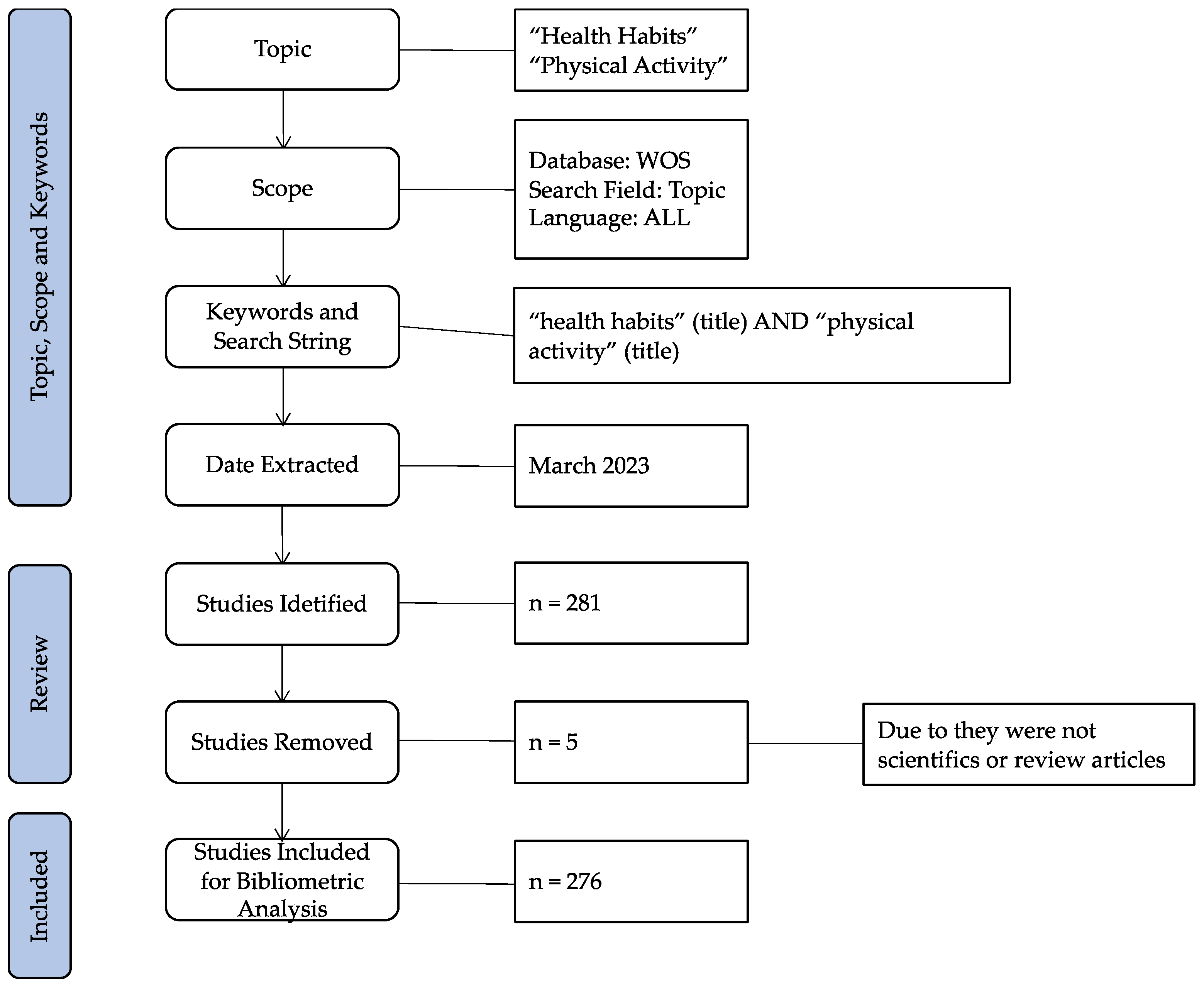
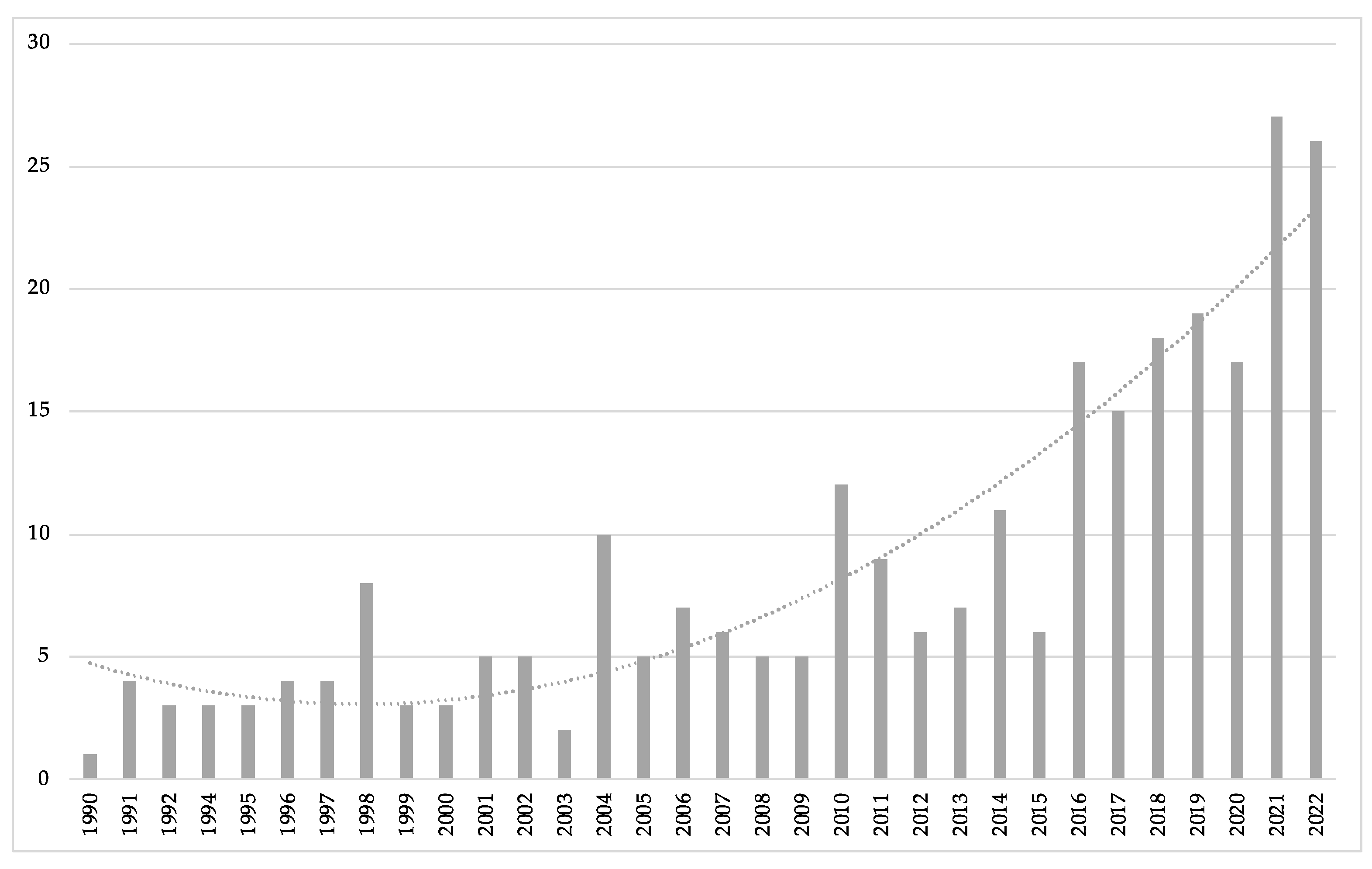
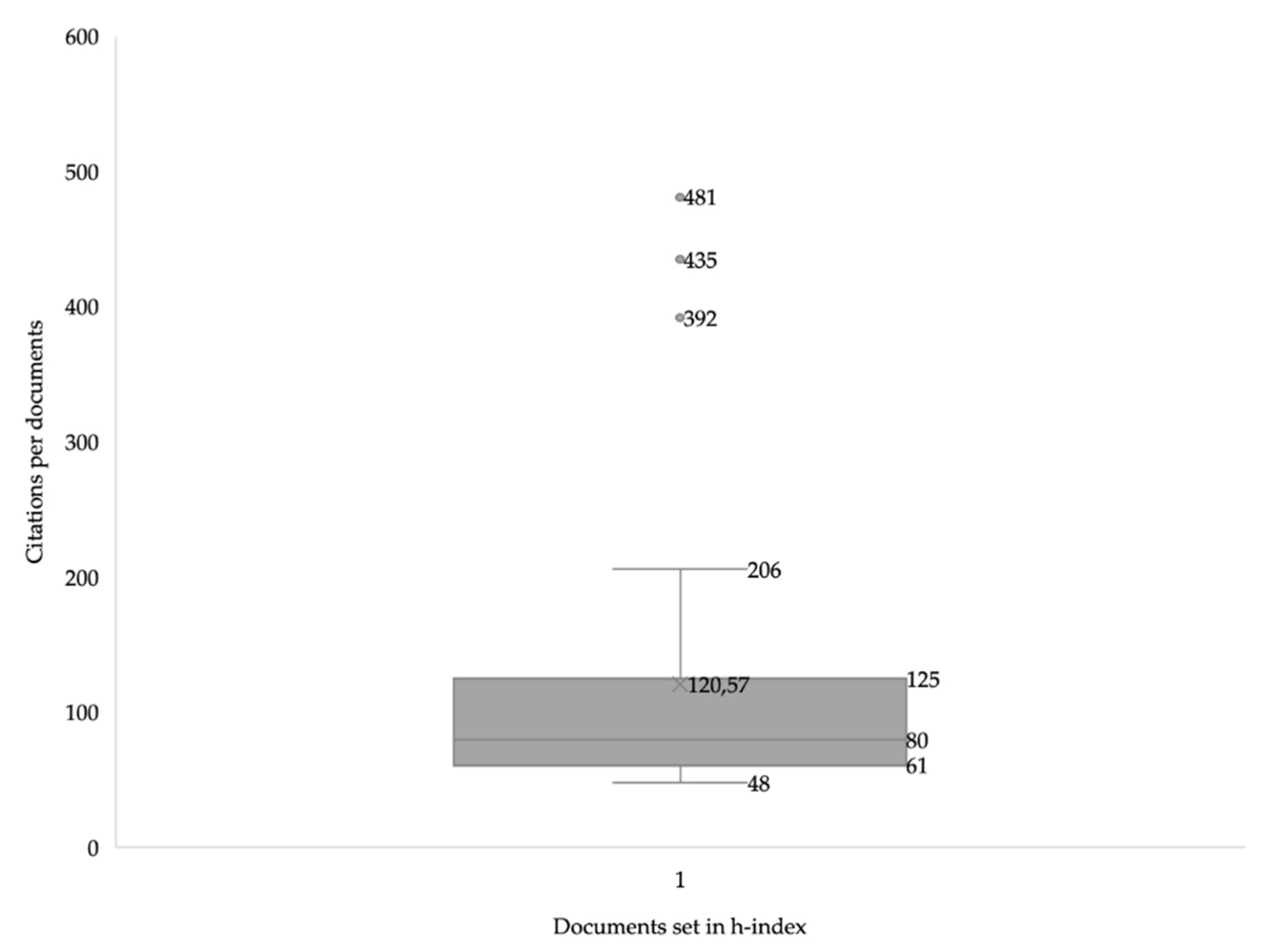
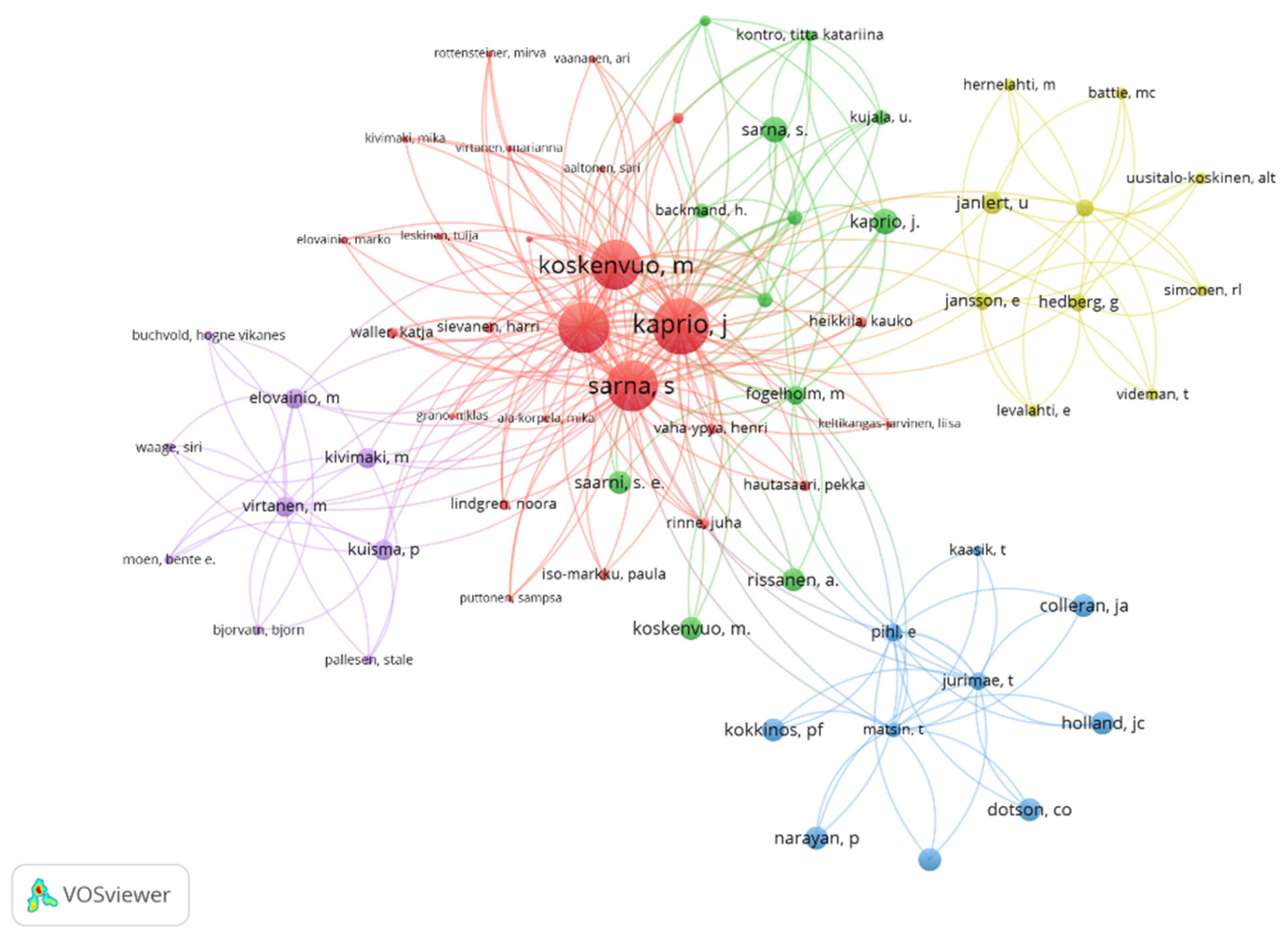
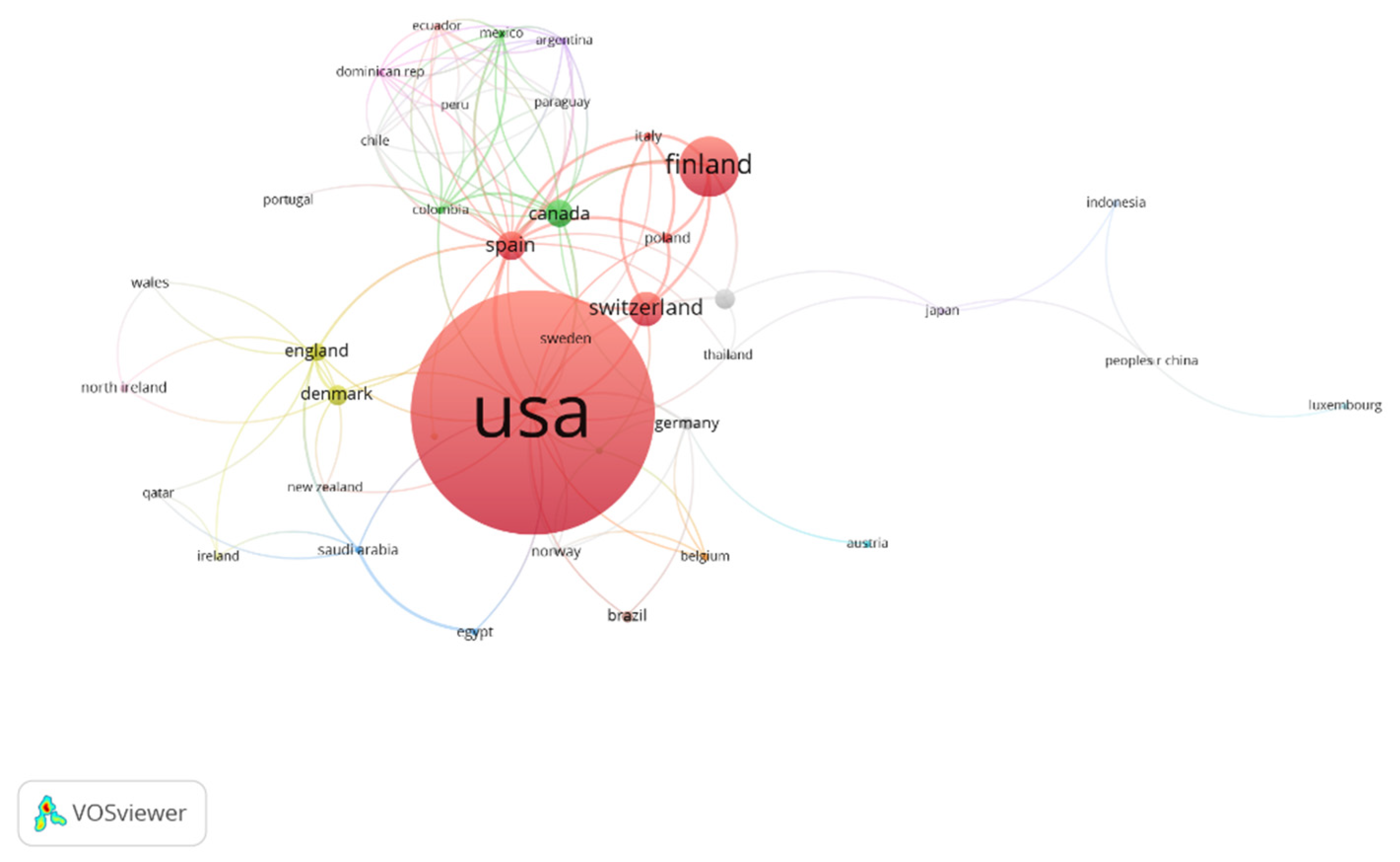
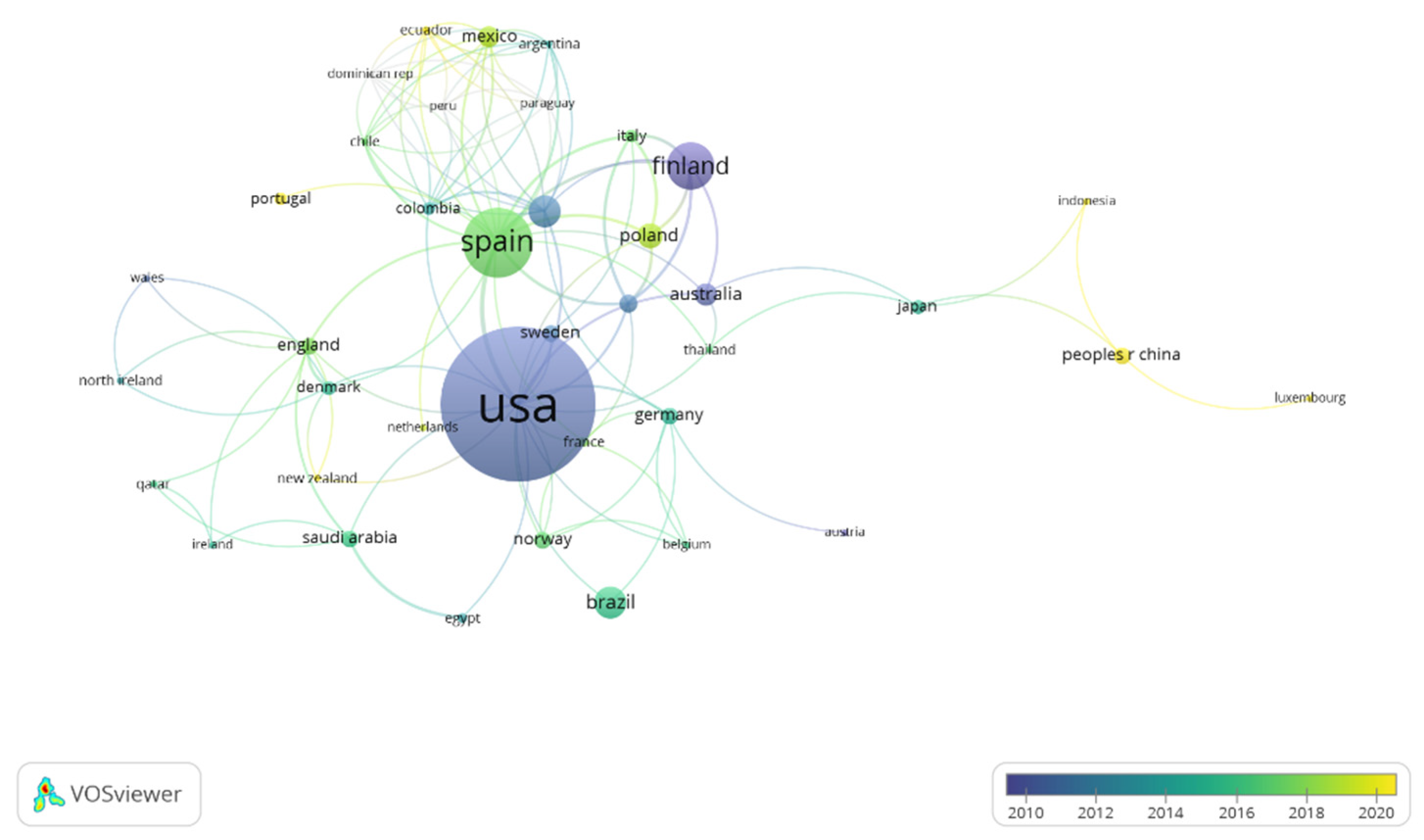

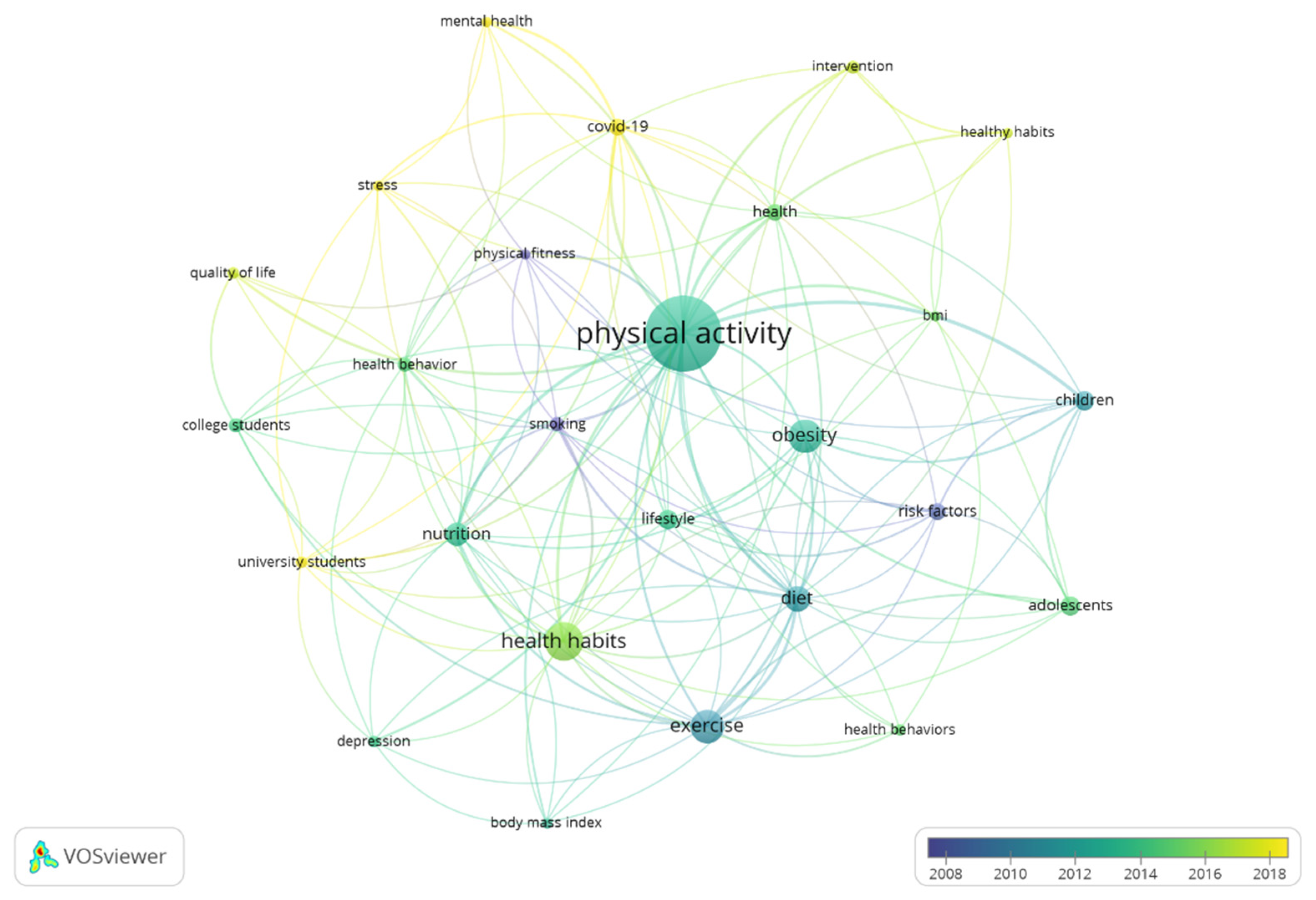
| Field | n | % |
|---|---|---|
| Public Environmental Occupational Health | 77 | 27.50% |
| Medicine General Internal | 32 | 11.43% |
| Nutrition Dietetics | 30 | 10.71% |
| Sport Sciences | 28 | 10.00% |
| Health Care Sciences Services | 15 | 5.36% |
| Nursing | 15 | 5.36% |
| Pediatrics | 13 | 4.64% |
| Education Educational Research | 11 | 3.93% |
| Environmental Sciences | 10 | 3.57% |
| Geriatrics Gerontology | 9 | 3.21% |
| Psychiatry | 9 | 3.21% |
| Psychology Multidisciplinary | 9 | 3.21% |
| Cardiac Cardiovascular Systems | 7 | 2.50% |
| Physiology | 7 | 2.50% |
| Psychology Clinical | 7 | 2.50% |
| Education Scientific Disciplines | 5 | 1.79% |
| Gerontology | 5 | 1.79% |
| Hospitality Leisure Sport Tourism | 5 | 1.79% |
| Medical Informatics | 5 | 1.79% |
| Multidisciplinary Sciences | 5 | 1.79% |
| Psychology Developmental | 5 | 1.79% |
| Clinical Neurology | 4 | 1.43% |
| Endocrinology Metabolism | 4 | 1.43% |
| Neurosciences | 4 | 1.43% |
| Rehabilitation | 4 | 1.43% |
Disclaimer/Publisher’s Note: The statements, opinions and data contained in all publications are solely those of the individual author(s) and contributor(s) and not of MDPI and/or the editor(s). MDPI and/or the editor(s) disclaim responsibility for any injury to people or property resulting from any ideas, methods, instructions or products referred to in the content. |
© 2023 by the authors. Licensee MDPI, Basel, Switzerland. This article is an open access article distributed under the terms and conditions of the Creative Commons Attribution (CC BY) license (https://creativecommons.org/licenses/by/4.0/).
Share and Cite
Hernández-Beltrán, V.; Espada, M.C.; Santos, F.J.; Ferreira, C.C.; Gamonales, J.M. Documents Publication Evolution (1990–2022) Related to Physical Activity and Healthy Habits, a Bibliometric Review. Healthcare 2023, 11, 1669. https://doi.org/10.3390/healthcare11121669
Hernández-Beltrán V, Espada MC, Santos FJ, Ferreira CC, Gamonales JM. Documents Publication Evolution (1990–2022) Related to Physical Activity and Healthy Habits, a Bibliometric Review. Healthcare. 2023; 11(12):1669. https://doi.org/10.3390/healthcare11121669
Chicago/Turabian StyleHernández-Beltrán, Víctor, Mário C. Espada, Fernando J. Santos, Cátia C. Ferreira, and José M. Gamonales. 2023. "Documents Publication Evolution (1990–2022) Related to Physical Activity and Healthy Habits, a Bibliometric Review" Healthcare 11, no. 12: 1669. https://doi.org/10.3390/healthcare11121669
APA StyleHernández-Beltrán, V., Espada, M. C., Santos, F. J., Ferreira, C. C., & Gamonales, J. M. (2023). Documents Publication Evolution (1990–2022) Related to Physical Activity and Healthy Habits, a Bibliometric Review. Healthcare, 11(12), 1669. https://doi.org/10.3390/healthcare11121669











